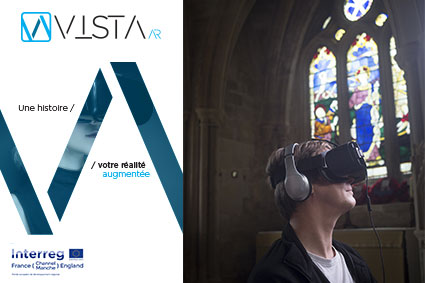Tourism in the Digital Age
Published on 03/21/2018
Thematics :


Tourism in the Digital Age
Published on 03/21/2018
When you visit a castle, would you like to see what it looked like through the ages, discover places that have disappeared or are inaccessible, or take part in a mediaeval banquet? All these experiences are now possible thanks to virtual reality headsets, tablets, smartphones and “immersion rooms”!
Innovative technologies are currently revolutionising heritage tourism in France and the United Kingdom through the European project VISTA-AR: Visitor experience Innovation through Systematic Text Analytics and Augmented Reality. Behind this acronym lies an ambition: to revitalise heritage site visits by proposing new, augmented reality experiences.
The Château de Fougères (in France) and Exeter Cathedral (United Kingdom) have been chosen as the first sites for the experiment. The researchers will analyse the behaviour and comments of visitors and create virtual or augmented reality experiences in line with their expectations.
For example, visitors will learn about everyday château life in the Middle Ages through a virtual reconstruction of the lord’s living quarters, which no longer exist. Visitors to Exeter will have access to the Cathedral’s 12th century treasures, which are kept in the cathedral’s archives, and interactively browse or even listen to books.
The possibility of adapting these systems – transferability – will then be tested at four other sites: the National Trust Tin Coast and the South West coast path in the United Kingdom, and the Valloires botanical gardens and Lorient Submarine Museum, in France.
VISTA-AR was officially launched in September 2017, and the project will last four years. It is funded by the European programme Interreg V, and coordinated by Exeter University. Eight partners will work on the project, on both sides of the English Channel, combining their expertise in the fields of tourism, digitisation, economics, and management.
Later, the systems developed by VISTA-AR will be made available to other heritage sites, with the creation of a library of shared digital resources, and will be easy to adapt to the needs of each site.
In addition to its enormous cultural interest, the project responds to an economic necessity: that of reinforcing the attractiveness of southern England and northern France. These regions are full of heritage sites and rely on them to generate tourism revenues. By creating a new way to visit these sites, VISTA-AR aims to increase the number of visitors: in other words, it hopes to simultaneously promote these shared natural heritage assets and support innovative, sustainable economic growth.
VISTA-AR aims to revolutionise both visitor experience and business models at cultural and historic heritage sites in France and the UK, and so contribute to their sustainability.
Total budget: 7.8 million euros; including 5.3 million euros from the European Regional Development Fund
VISTA –AR’s partners:
• Exeter University
• Brittany Regional Council
• The town of Fougères
• Bournemouth University
• Le Centre des Etudes Supérieures Industrielles (CESI)
• NEOMA Business School
• L’Ecole Européenne Supérieure d’Art de Bretagne (EESAB)
• The Corporate Body of the Cathedral of St Peter
Related articles and videos:

Programme priority: To realise the potential of natural and cultural assets to deliver innovation and sustainable growth.
The allocated budget is €8,292,568.68 with European Regional Development Fund (ERDF) co-funding of 69%.
This includes an extension with budget awarded in November 2020 to allow the project to mitigate the risks of the pandemic.
